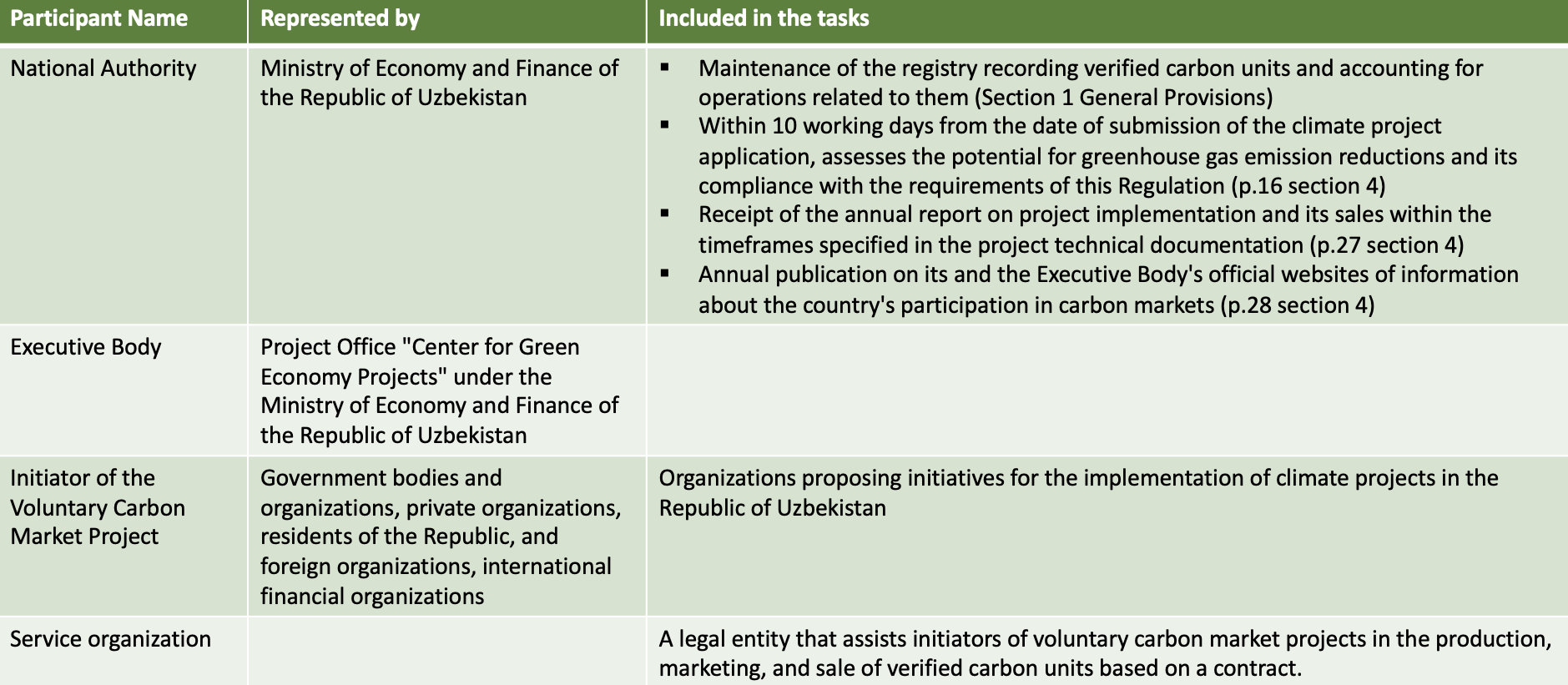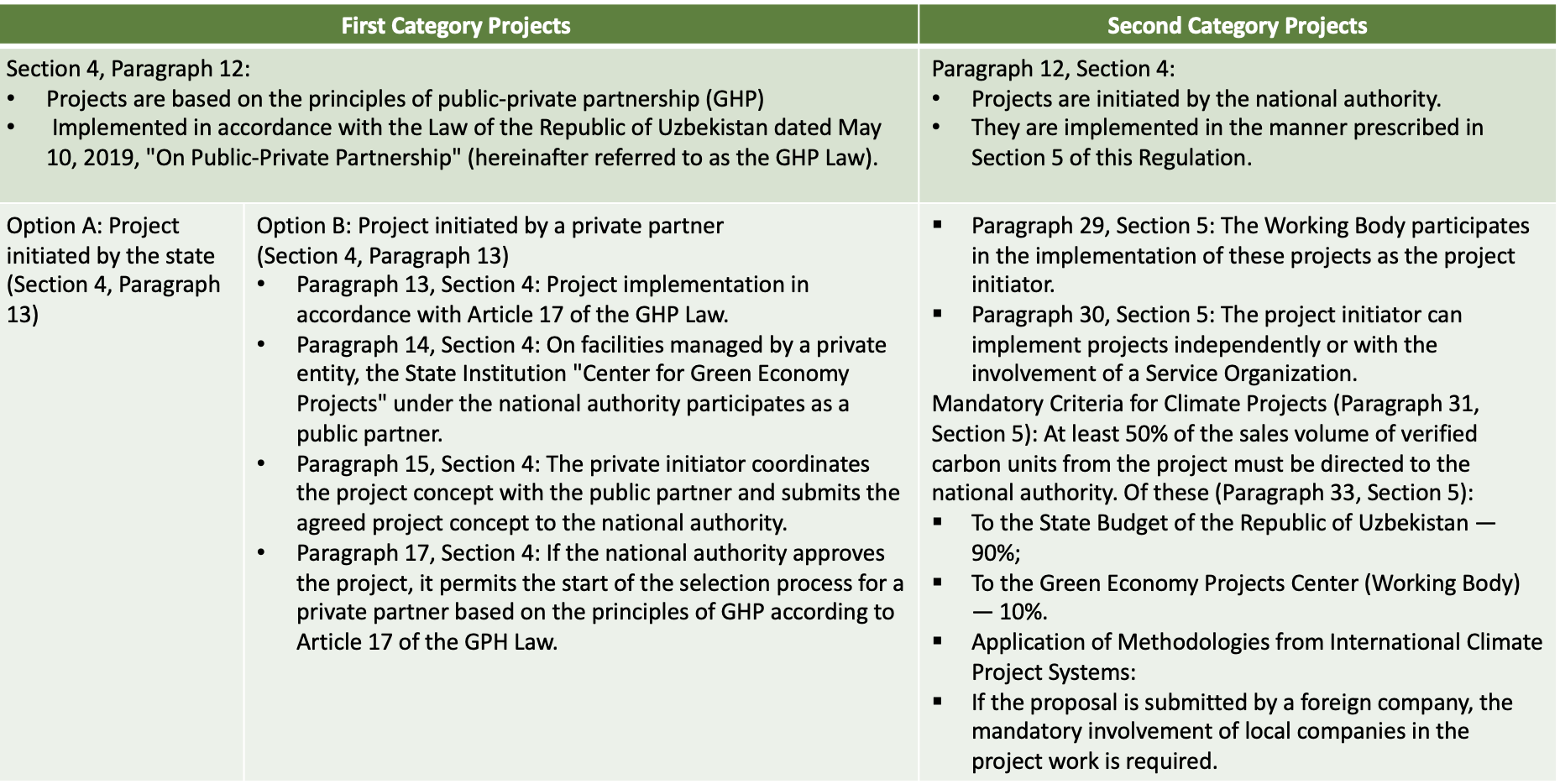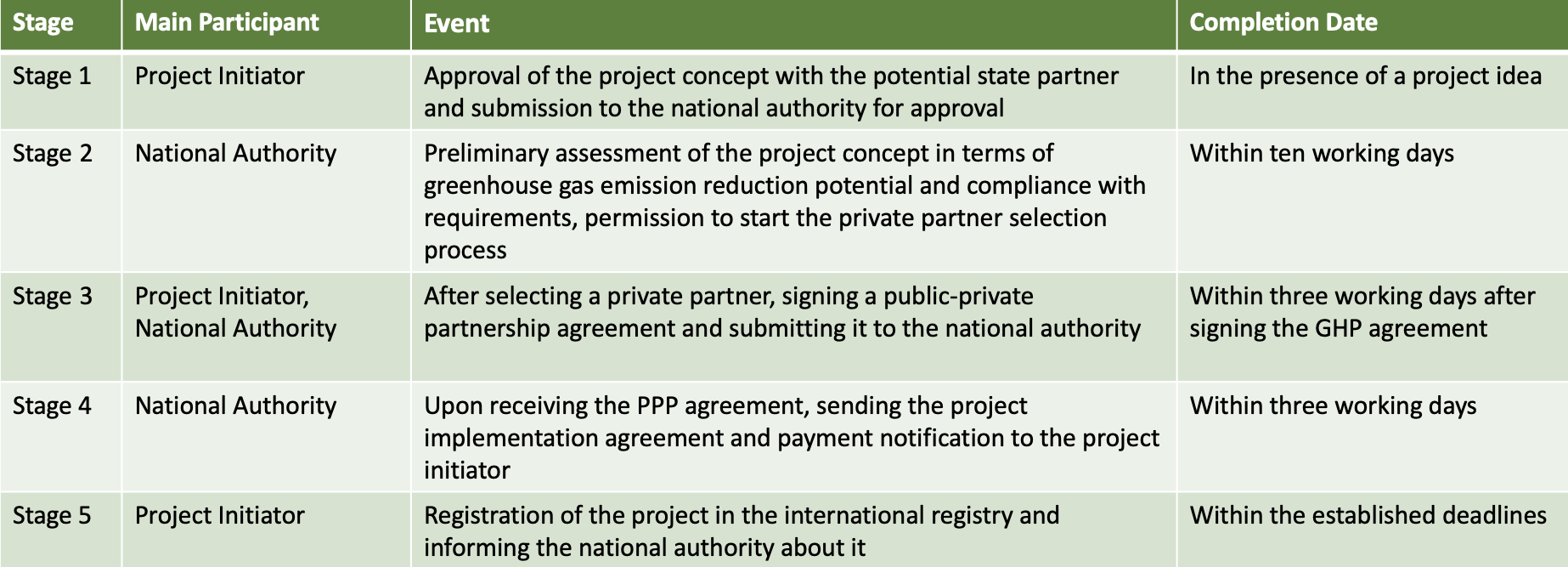Got questions? Send us an email:
info@hpbs.uz
Temporary Regulation on the Implementation of Greenhouse Gas Emissions Trading Projects in Uzbekistan
On March 7, 2024, the Cabinet of Ministers of the Republic of Uzbekistan issued Resolution No. 117 on the temporary regulation concerning projects related to greenhouse gas emissions trading. Below are the key points of this Regulation.
1. Responsible Parties
Executive Body - Ministry of Economy and Finance of the Republic of Uzbekistan
According to the Presidential Decree of the Republic of Uzbekistan dated December 2, 2022, No. PQ-436, the Ministry of Economy and Finance is designated as the Executive Body responsible for:
- Regulation,
- Implementation,
- Coordination,
- Management of greenhouse gas emissions trading at both international and national levels,
- Monitoring and reporting within the framework of these projects.
From March 10, 2024: all projects aimed at reducing greenhouse gas emissions and generating carbon units must be approved by the Ministry of Economy and Finance of the Republic of Uzbekistan.
Responsibilities of the Ministry of Economy and Finance of the Republic of Uzbekistan:
- Coordinate the timely review and implementation of proposals for projects on the voluntary carbon market, as well as the realization of verified carbon units and directing revenues to the state budget.
- Provide monthly analytical information to the Administration of the President of the Republic of Uzbekistan regarding the attraction of investment projects to the voluntary carbon market and their effectiveness.
Ministry of Energy in cooperation with interested ministries and agencies:
- Organize the registration of carbon units according to international standards based on projects implemented in the energy sector, including those based on public-private partnerships involving foreign investors.
- Ensure effective exchange of necessary financial and technical data with the national authority.
Government of the Republic of Uzbekistan
From March 10, 2024: control the volume of reduced greenhouse gas emissions resulting from projects implemented in partnership with foreign and local investors within the framework of public-private partnerships or other forms.
2. Main Participants

3. Project Directions
Renewable Energy Projects:
Providing national or regional grids with energy from renewable sources such as:
- Solar,
- Wind,
- Hydropower,
- Waste and biomass,
As well as expanding renewable energy sources connected to small grids or operating off-grid.
Reforestation Projects:
- Planting trees,
- Sustainable tree cultivation,
- Improving and expanding all forest systems, agroforestry, or pastures.
Water, Sanitation, Hygiene, and Green Buildings:
- Projects aimed at mitigating climate change and/or adapting to it.
Energy Efficiency Projects:
- Implementing technologies and solutions that reduce energy consumption without compromising the volume and quality of services or products.
Green and Low-Carbon Industry Development Projects:
- Reducing resource consumption and greenhouse gas emissions in the industry,
- Implementing innovative low-waste technologies,
- Attracting efficient green investments.
Waste Management and Recycling:
- Implementing sustainable practices for producing energy or useful products (composting, biogas, etc.) in waste management.
4. Project Categories
First Category:
- All investment projects implemented in the territory of the Republic of Uzbekistan,
- Aimed at reducing greenhouse gas emissions and producing verified carbon units,
- Implemented in accordance with Section 4 of the Regulation.
Second Category:
- Projects implemented within the framework of public-private partnerships or with the participation of state organizations and enterprises (as customers),
- Aimed at producing verified carbon units based on the reduction of greenhouse gas emissions,
- Implemented in accordance with Section 5 of the Regulation.

5. Key Methodological Elements of Climate Projects
Climate Project Methodologies
Section 3 outlines the methodology for the development, implementation, and monitoring of voluntary carbon market projects. The following international climate project systems are authorized for use:
- "Gold Standard"
- "Verra's Verified Carbon Standard"
- "Clean Development Mechanism"
- ISO 14064 standards — guidelines for the quantification, monitoring, and reporting of greenhouse gas emission reductions (or removals)
The list of methodologies is regularly updated by the national authority.
Prevention of Double Counting of Carbon Units
To prevent double counting of carbon units, voluntary carbon market projects cannot be registered in more than one national, international, or independent carbon unit system (Section 1, General Provisions, Clause 3).
6. Requirements for Voluntary Carbon Market Projects
Section 1, Clause 7, Restrictions on the Volume of Verified Units:
Projects are allowed to produce verified emission units not exceeding 1% of the country's annual greenhouse gas emissions for the previous year, as stated in the biennial updated report under the nationally determined contributions (NDC).
Section 2, Clause 8, Reserve Carbon Units:
The national authority reserves 1% of the volume of verified carbon units to mitigate the risk of overselling under the Paris Agreement. The national authority annually publishes information on the use of general reserve units.
Section 2, Clause 9, Accounting of Verified Carbon Units for National Goals:
Verified carbon units generated by projects are not transferred or used as international mitigation outcomes (ITMO) for the purposes of the nationally determined contributions (NDC) of other countries.
7. Scheme for the Development, Approval, Implementation, and Monitoring of Voluntary Carbon Market Projects
(Appendix 1 to the Temporary Regulation on the Procedure for Implementing Projects Related to International Trade in Greenhouse Gases)


8. Next Steps for the Development of the Carbon Market According to This Regulation
Ministry of Economy and Finance of the Republic of Uzbekistan
- In cooperation with the Ministry of Digital Technologies, digitize the system for reviewing, approving, and monitoring proposals for voluntary carbon market projects and ensure the ability to track each stage of project implementation.
- By October 1, 2024: In cooperation with the Ministry of Ecology, Environmental Protection, and Climate Change, develop a program for the introduction of international carbon markets and non-market mechanisms in the Republic of Uzbekistan, including cooperative approaches and sustainable development mechanisms in accordance with Articles 2 and 4 of the Paris Agreement.
- Establish the maintenance of a National Registry of Carbon Units to account for reduced greenhouse gas emissions and the production of verified carbon units.
If you have any questions, you can write to our email info@hpbs.uz or call +99890 9306566.
Author of the article: Marina Kupriyanova